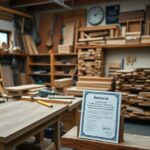Insurance protection for your woodworking business involves more than just basic liability coverage. As a woodworking professional, you face unique risks that require specific insurance solutions tailored to your craft.
Your workshop, tools, and finished products need comprehensive protection against accidents, damage, and potential legal claims.
Whether you’re running a small custom furniture shop or a large-scale woodworking operation, understanding your coverage options helps you make informed decisions about safeguarding your business assets and professional reputation.
Woodworking Insurance Coverage Options
The protection of your woodworking assets requires comprehensive property coverage to safeguard your business investments.
This type of insurance shields your physical assets from losses due to fire, theft, vandalism, and natural disasters, ensuring your business can recover and continue operations after unexpected events.
Tools and Equipment Protection
An necessary aspect of your woodworking insurance plan should include coverage for your valuable tools and equipment.
This protection extends to both stationary and portable machinery, hand tools, and specialized equipment, whether they’re stored in your workshop or transported to job sites. Your policy can be customized to cover replacement costs or actual cash value.
Workshop Structure Insurance
By securing proper coverage for your workshop building, you protect the foundation of your woodworking business.
This insurance covers the physical structure, including walls, roof, electrical systems, and built-in equipment against damage from covered perils.
Tools and finished products stored in your workshop need protection too, which is why your workshop structure insurance should extend beyond just the building itself.
You’ll want to consider coverage that includes improvements you’ve made to the space, storage systems, and permanent fixtures.
This comprehensive approach ensures that both your workspace and its contents receive adequate protection.
Liability Protection
Some of your most significant risks as a woodworking business owner come from potential accidents and product-related claims.
Your comprehensive liability protection should address both direct accidents on your premises and issues that might arise from your finished products.
Having proper liability coverage helps you maintain financial stability and protects your business assets against unexpected legal challenges.
General Liability Coverage
Liability coverage safeguards your woodworking business against third-party claims involving bodily injury or property damage.
When clients visit your workshop, this insurance covers potential slip-and-fall accidents, injuries from falling objects, or damage to their personal property.
Your policy typically includes coverage for medical expenses, legal defense costs, and settlements if you’re found liable.
Product Liability Insurance
Between crafting custom furniture and producing wooden items for sale, you need protection against claims arising from your finished products.
Product liability insurance covers you if a customer experiences injury or property damage due to alleged defects in your woodwork, from loose joints to finishing materials that cause reactions.
At times, product-related claims can surface months or even years after you’ve completed a piece. Your product liability coverage extends to issues like structural failures, material defects, or design flaws that might emerge over time.
This protection helps cover legal expenses, settlements, and potential medical costs if your woodwork is found to have caused harm or damage.

Professional Coverage
Not all woodworking risks are covered by general liability insurance. Your professional coverage protects you against claims arising from errors, oversights, or negligence in your woodworking services.
This includes design flaws, measurement mistakes, or failure to meet project specifications that result in financial losses for your clients.
Business Interruption Insurance
With this coverage, your woodworking business stays financially secure when unexpected events force you to temporarily close your shop.
It helps replace lost income and covers ongoing expenses like rent, utilities, and payroll during the shutdown period, allowing you to maintain stability until operations resume.
Workers’ Compensation
An vital part of your woodworking business insurance portfolio, workers’ compensation provides coverage for your employees’ medical expenses and lost wages if they get injured while working in your shop or at installation sites.
A comprehensive workers’ compensation policy protects your business from potential lawsuits while ensuring your employees receive proper care. You’ll need this coverage if you have employees, and in most states, it’s legally required.
The policy costs vary based on your payroll size, claims history, and the specific risks associated with your woodworking operations.
Specialized Protection
All woodworking operations require tailored insurance solutions that align with your specific business needs. Your specialized protection should encompass comprehensive coverage for your tools, equipment, and finished products, while also safeguarding against unique risks associated with custom woodworking projects.
Project-Specific Coverage
Against potential losses during specific woodworking projects, you can secure dedicated coverage that protects your work from start to finish.
This targeted insurance ensures your custom pieces are protected throughout the creation process, from initial design to final installation at your client’s location.
Material Transit Insurance
To protect your valuable materials and finished products during transportation, you need specialized transit coverage.
This insurance safeguards your woodworking materials and completed pieces while they’re being moved between your workshop, suppliers, and customers’ locations.
Insurance for material transit can be customized to match your specific transportation needs. You can choose coverage levels based on your typical shipment values, frequency of deliveries, and transportation methods.
This protection extends to damage from accidents, theft, and environmental factors during transit, ensuring your business stays protected beyond your workshop walls.
Risk Assessment
Your woodworking business faces unique risks that require careful evaluation. From tool-related injuries to property damage, understanding potential hazards helps you determine appropriate insurance coverage.
A thorough assessment of your workshop, equipment, employees, and business operations enables you to identify vulnerabilities and implement necessary protective measures.
Workshop Safety Measures
About 70% of workshop incidents can be prevented through proper safety protocols. Your insurance provider expects you to maintain specific safety standards, including proper ventilation, fire prevention systems, and organized workspaces. Installing security systems, maintaining emergency exits, and providing adequate lighting can reduce your insurance premiums while protecting your assets.
Coverage Evaluation Methods
For effective insurance coverage, you need to accurately assess your business value and risk exposure. This includes evaluating your equipment worth, inventory levels, annual revenue, and number of employees. Regular updates to your coverage ensure your policy aligns with your business growth.
With detailed documentation of your assets and regular policy reviews, you can optimize your coverage levels.
Consider creating an itemized list of your equipment, maintaining records of safety improvements, and tracking business growth metrics.
These practices help you adjust your coverage as needed and streamline the claims process if an incident occurs.
Cost Considerations
Now, as a woodworking business owner, you’ll need to carefully evaluate your insurance costs against your operational needs and budget.
Your coverage costs will vary based on multiple factors including your business size, location, and specific risk exposures.
Finding the right balance between comprehensive protection and affordable premiums helps ensure your business’s long-term sustainability.
Premium Factors
Against the backdrop of diverse woodworking operations, your insurance premiums are shaped by several key elements:
- Your annual revenue and project scope
- Your workshop’s square footage and location
- The types of machinery and equipment you use
- Your safety protocols and claims history
- The number of employees you have
Recognizing these factors allows you to make informed decisions about your coverage options.
Deductible Options
Around your policy’s deductible choices, you’ll find various options that can help manage your premium costs. Higher deductibles typically result in lower premium payments, while lower deductibles mean higher monthly costs but less out-of-pocket expense when filing a claim.
Understanding your deductible options requires evaluating your financial capacity to handle unexpected costs. You should assess your business’s cash flow and risk tolerance when selecting deductible amounts.
A balanced approach between manageable deductibles and premium costs ensures your woodworking business maintains appropriate coverage while staying within budget constraints.
Summing up
So, when selecting your woodworking insurance coverage, you’ll need to consider multiple layers of protection for your business.
Your comprehensive plan should include general liability to protect against third-party claims, property insurance for your tools and workshop, workers’ compensation if you have employees, and product liability for your finished pieces.
You can customize your coverage by adding specific endorsements that match your unique business needs, ensuring you’re protected against the distinct risks associated with woodworking operations.







